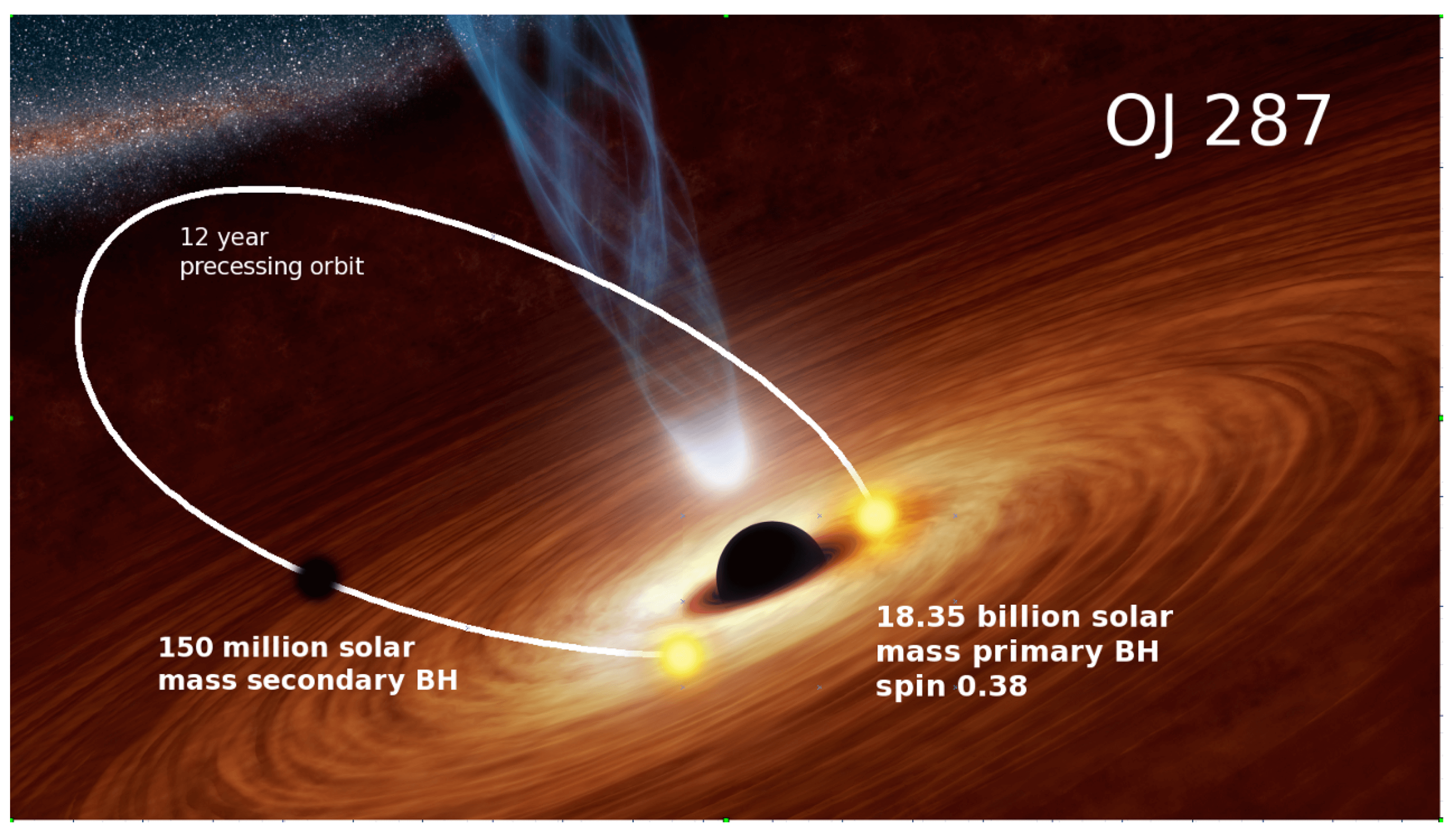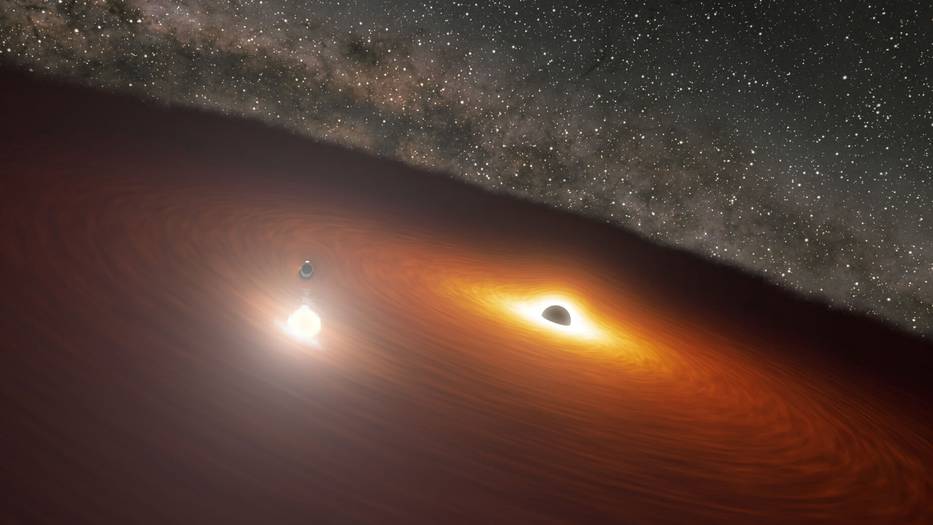This image shows two massive black holes in the OJ 287 galaxy. The smaller black hole orbits the larger one, which is also surrounded by a disk of gas. When the smaller black hole crashes through the disk, it produces a flare brighter than 1 trillion stars. Image © NASA/JPL-Caltech
Black holes have long been a mysterious and a special topic for astronomers and also to the layman. This mysterious region in space can not be seen directly as even light can not escape from its extensive gravitational pull and as it sucks all the material that comes into its region as in the giant hole; named accordingly - the black hole. Astronomers think that black holes can unravel until incomprehensible subjects like wormhole, multiverse, and dark matter and they are in continuous hunt of black holes and understand them. Though trailing methods of black holes vary depending on what we need, one major method is through studying the gravitational waves. Gravitational waves are ripples/disturbance in the curvature of space-time caused by some of the most violent and energetic processes in the universe.
I suspect you hearing about gravitational wave; you must be thinking that to be only from black holes. But here, remember that gravitational waves don't mean it must be from black holes only; it can be from black holes merging, or neutron stars, or black holes and neutron stars. The first gravitational waves that were generated by the merging two black holes were detected by LIGO in 2015, and subsequently, they were able to record weird gravitational waves like from uneven sized black holes and intermediate-mass black holes.
Detecting the gravitational waves let astronomers analyse different properties of black holes like mass, their types, distance from us, the time frame of their merging and many more types of technical properties.
Adding to the properties of black holes, in a new study published in the Astrophysical Journal Letters, researchers report that the previously studied model that is able to predict the timing of future flares to within four hours holds correct. The previous model was studied by a group of scientists led by Lankeswar Dey, a graduate student at the Tata Institute of Fundamental Research in Mumbai, India in 2018.
Also Read: How Advanced LIGO Works and What we can Learn from Gravitational Waves?
Based on their accurate prediction of a flare that occurred on July 31, 2019, they confirm the previous model is correct.
Scientists have finally figured out the precise timing of a complicated dance between two enormous black holes, revealing hidden details about the physical characteristics of these mysterious cosmic objects.
The team analyzed the multi-epoch Spitzer observations of the expected flare between 2019 July 31 and 2019 September 6, as well as baseline observations during 2019 February-March of the binary black holes that lie in the heart of galaxy OJ 287.
At the centre of the galaxy OJ 287, there lies black holes of mass over 18 billion and of about 150 million times the Sun's mass. While revolving around the larger mass black hole, twice every 12 years, the smaller black hole crashes through the enormous disk of gas surrounding its larger companion and creates a flash of light brighter than a trillion stars that is brighter than the entire Milky Way galaxy. The light takes 3.5 billion years to reach Earth.

But it is a fact that the smaller black hole’s orbit is not the same as that of a large mass: their orbit is not regular and circular. Smaller mass black hole shifts its orbital position with each loop around the bigger black hole and is tilted relative to the disk of gas.
When the smaller black hole crashes through the disk, it creates two expanding bubbles of hot gas that move away from the disk in opposite directions, and in less than 48 hours the system appears to quadruple in brightness. Because of the irregular orbit, the black hole collides with the disk ejecting flares at different times during each 12-year orbit and sometimes less but more than 10 years.
But in 2010, scientists created a model that could predict their occurrence to within about one to three weeks and they demonstrated it too. They tried their new model on a flare in December 2015 and predicted the appearance within three weeks.
"When I first checked the visibility of OJ 287, I was shocked to find that it became visible to Spitzer right on the day when the next flare was predicted to occur," said Seppo Laine, an associate staff scientist at Caltech/IPAC in Pasadena, California, who oversaw Spitzer's observations of the system. "It was extremely fortunate that we would be able to capture the peak of this flare with Spitzer because no other human-made instruments were capable of achieving this feat at that specific point in time."
Then in 2018 a group of scientists led by Lankeswar Dey, a graduate student at the Tata Institute of Fundamental Research in Mumbai, India, published a paper with an even more detailed model they claimed would be able to predict the timing of future flares to within four hours and this recent study confirmed that Dey’s team was correct.
As mentioned above, scientists rely on the gravitational waves for detailing black holes and so too. Larger the object’s mass, larger and more energetic the gravitational waves it creates. Hinging on this fact, scientists expect that the gravitational waves from OJ 287 system to be so large that they can carry enough energy away from the system to measurably alter the smaller black hole's orbit - and therefore the timing of the flares.
Though the previous studies of the OJ 287 system accounted for the gravitational waves, the studies were not detailed as of the 2018 model. By incorporating information gathered from LIGO's detections of gravitational waves, it refines the window in which a flare is expected to occur for just 1 1/2 days.
Here the new model incorporates something called the "no-hair" theorem of black holes which in general states that black holes can be characterized by only three externally observable classical parameters: mass, electric charge, and angular momentum. No-hair theorem was published in the 1960s by a group of physicists that included Stephen Hawking where they successfully make a prediction about the nature of black hole surfaces. While black holes don't have true surfaces, scientists know there is a boundary around them beyond which nothing - not even light - can escape. Some ideas posit that the outer edge, called the event horizon, could be bumpy or irregular, but the no-hair theorem posits that the surface has no such features, not even hair (the theorem's name was a joke).
"It is important to black hole scientists that we prove or disprove the no-hair theorem. Without it, we cannot trust that black holes as envisaged by Hawking and others exist at all," said Mauri Valtonen, an astrophysicist at the University of Turku in Finland and a coauthor on the paper.
The new model supports the no-hair theorem by correctly anticipating the orbit of smaller black holes with higher precision. This indicates that our basic understanding of these incredibly strange cosmic objects is correct. The OJ 287 system, in other words, supports the idea that black hole surfaces are symmetric along their rotational axes.
You may be wondering how really the smoothness of the massive black hole's surface impacts the timing of the smaller black hole's orbit? Here is the answer; as in the typical case, the orbit of black hole is also determined by the mass of the larger black hole. As time passes, the larger mass black holes become more massive and that would change the size of the smaller black hole's orbit. In this process, the distribution of mass/matters may create a massive bulge on one side of the larger black hole that would distort the space around it differently than if the black hole were symmetric. This will ultimately alter the path of the smaller black hole as it orbits its companion and measurably changes the timing of the black hole's collision with the disk on that particular orbit.
